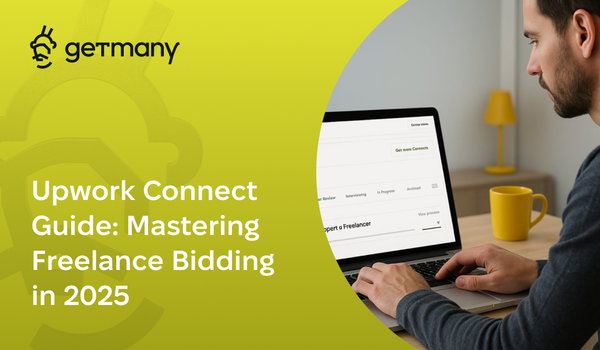Understanding Upwork's Fee Structure for Agencies
Master Upwork's fees to maximize profitability. Turn the platform's cost structure from a burden into a strategic advantage with advanced optimization tactics.
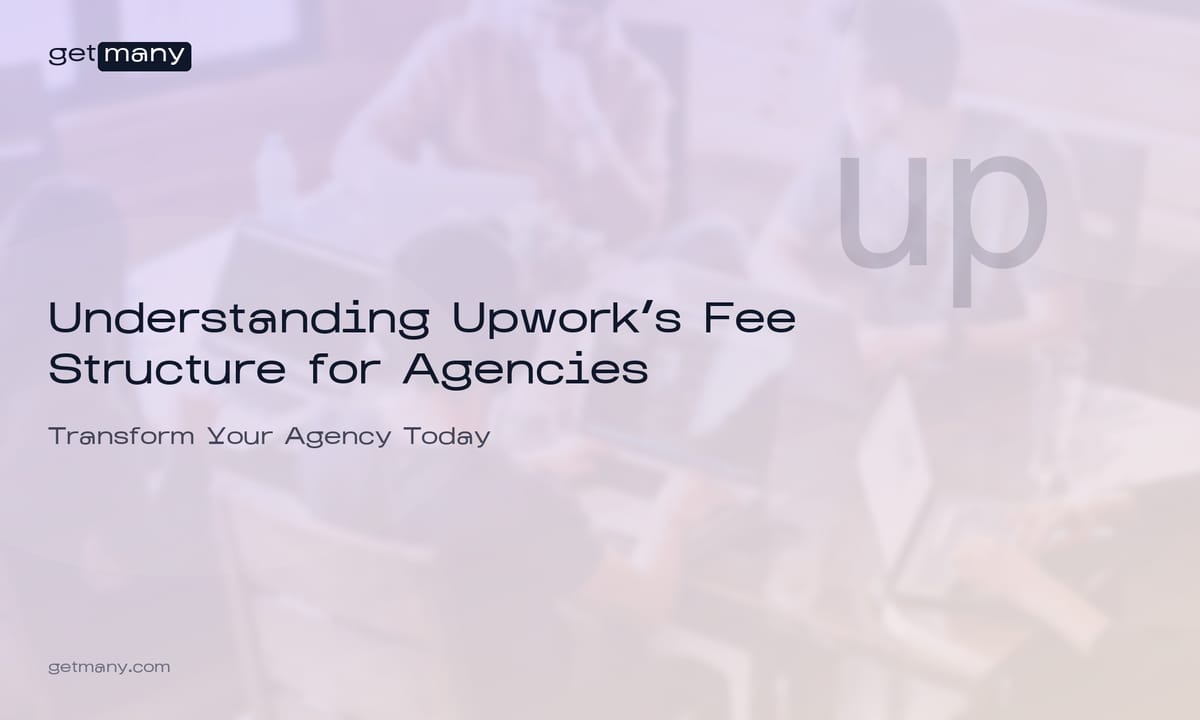
Last week, an agency owner called me in frustration: "We billed $50,000 last month but only kept $42,500. Where did our money go?" After walking through their Upwork fee structure, they realized they'd been calculating margins wrong for two years, underpricing services by 15%.
Understanding Upwork's fee structure isn't just about knowing the percentages - it's about strategically structuring your business to maximize take-home revenue. The difference between agencies that complain about fees and those that thrive despite them? The latter understand how to work with the system, not against it.
This comprehensive guide breaks down every aspect of Upwork's fees, reveals strategies to minimize their impact, and shows you how to turn the fee structure into a competitive advantage.
The Complete Fee Breakdown
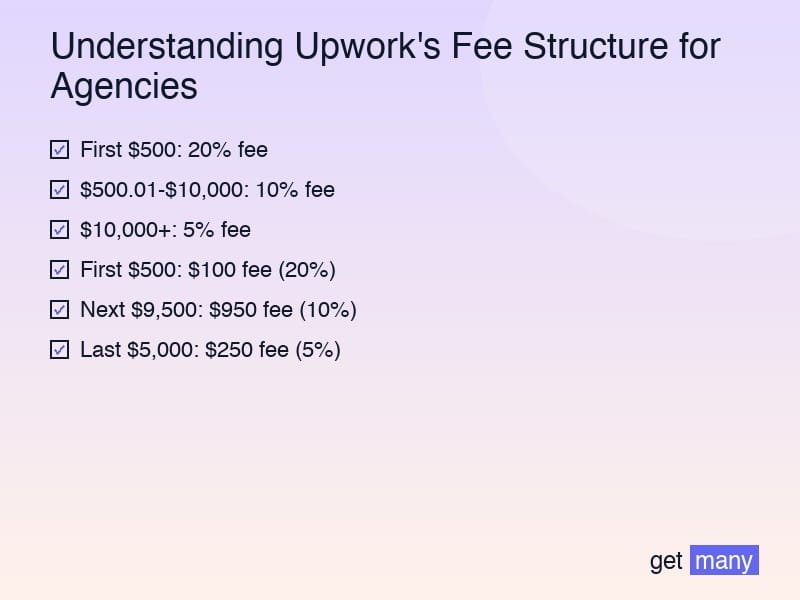
Let's start with the facts about what Upwork charges:
Standard Freelancer Service Fees
Upwork uses a sliding scale based on lifetime billings with each client:
Fee Structure:
- First $500: 20% fee
- $500.01-$10,000: 10% fee
- $10,000+: 5% fee
Example Calculation: $15,000 project with new client:
- First $500: $100 fee (20%)
- Next $9,500: $950 fee (10%)
- Last $5,000: $250 fee (5%)
- Total fees: $1,300 (8.67% effective rate)
Agency-Specific Considerations
Key Differences for Agencies:
- Fees apply per client, not per agency
- Each team member's earnings count toward thresholds
- Freelancer Plus benefits apply agency-wide
- Enterprise clients have different structures
Additional Fee Types
Connect Fees:
- $0.15 per connect
- 2-16 connects per proposal
- 70 free connects with Plus membership
Payment Processing:
- Direct deposit: $0.99 per transfer
- Wire transfer: $30 per transfer
- PayPal: 2% up to $1
- Payoneer: Standard rates apply
Optional Services:
- Freelancer Plus: $14.99/month
- Boosted proposals: Variable pricing
- Featured profile: $29.99-299.99
The Hidden Costs Agencies Miss
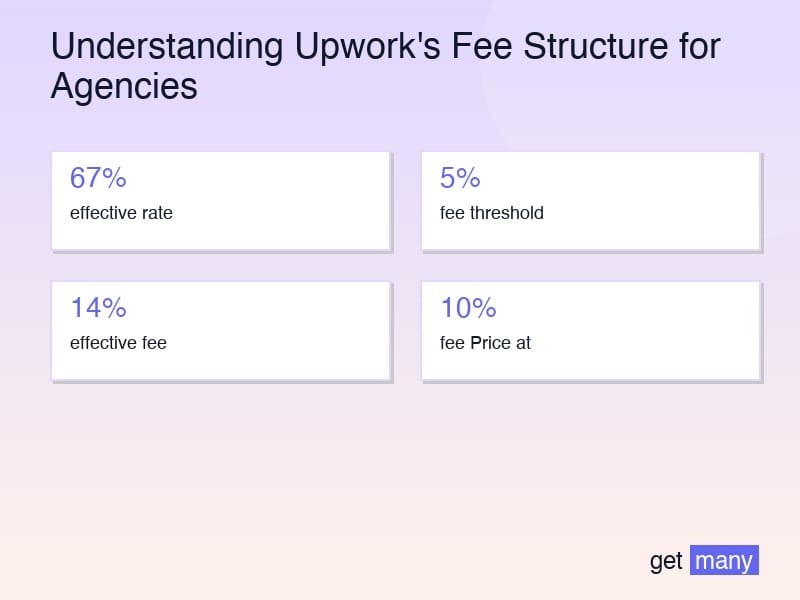
Beyond obvious fees, consider these impacts:
Cash Flow Timing
Payment Delays:
- Security period: 5 days minimum
- Processing time: 1-3 days
- Total delay: 6-10 days typically
Impact on $50K/month agency:
- Float requirement: $12-15K
- Interest opportunity cost: $150-200/month
- Working capital needs: +20%
Currency Conversion
International Client Costs:
- Upwork conversion rate: 2-3% markup
- Additional processing fees
- Rate fluctuation risks
Mitigation Strategy: Price in USD globally to avoid conversion losses.
Time Investment Costs
Platform Activities (unbillable):
- Proposal writing: 5-10 hours/week
- Client communication: 3-5 hours/week
- Admin tasks: 2-3 hours/week
- Total: 10-18 unbillable hours
True Cost Calculation: If your rate is $100/hour, platform time costs $1,000-1,800 weekly in opportunity cost.
Strategic Fee Optimization
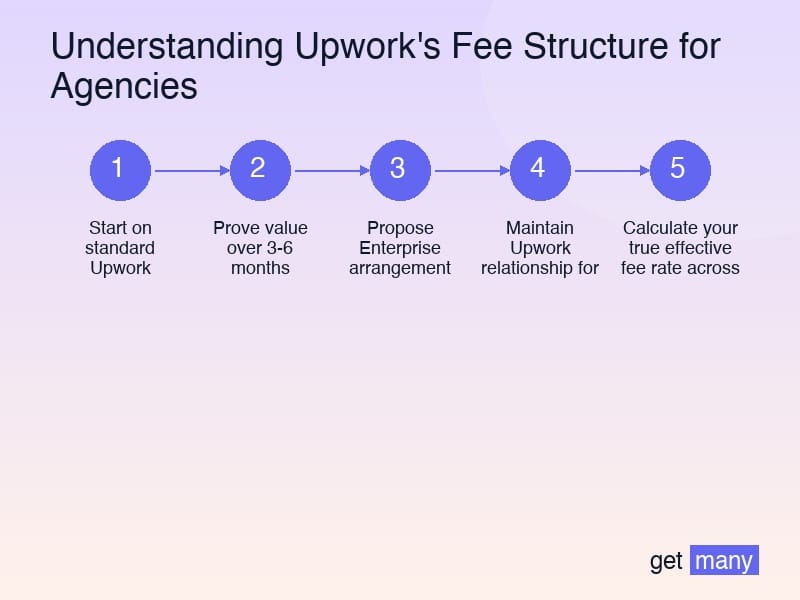
Transform fees from burden to manageable cost:
The Lifetime Value Strategy
Focus on Long-Term Clients:
- Quickly reach 5% fee threshold
- Improve profitability over time
- Build predictable revenue
- Reduce acquisition costs
Client Development Path: ``` Month 1: $3,000 (14% effective fee) Month 2: $3,000 (10% fee) Month 3: $3,000 (10% fee) Month 4: $3,000 (5% fee) Months 5+: $3,000 (5% fee ongoing) ```
Average fee over 12 months: 6.25% vs 20% for one-off projects.
The Pricing Adjustment Formula
Account for fees in your pricing:
Correct Pricing Calculation: ``` Target Net Rate = Desired Income / (1 - Fee Percentage)
Example: Want $100/hour net with 10% fee Price at: $100 / 0.90 = $111.11/hour ```
Common Mistake: Agencies add fees on top instead of calculating backwards, resulting in lower net rates.
The Milestone Structure Advantage
Structure contracts to minimize fee impact:
Smart Milestone Setup:
- First milestone: $500 (gets 20% fee out of way)
- Subsequent milestones: Larger amounts
- Back-load bigger payments at 5% fee
Example Structure: $10,000 project:
- Milestone 1: $500 (20% fee = $100)
- Milestone 2: $2,000 (10% fee = $200)
- Milestone 3: $3,500 (10% fee = $350)
- Milestone 4: $4,000 (5-10% fee = $300)
Total fees: $950 vs $1,100 if structured differently
Advanced Fee Strategies
The Enterprise Client Advantage
Benefits of Enterprise Clients:
- No Upwork fees after contract
- Direct payment processing
- Simplified administration
- Better payment terms
Qualification Criteria:
- Large companies with compliance needs
- Ongoing relationships
- High-value contracts
- Payment reliability
Transition Strategy:
- Start on standard Upwork contract
- Prove value over 3-6 months
- Propose Enterprise arrangement
- Maintain Upwork relationship for new work
The Portfolio Effect
Diversify client types for fee optimization:
Ideal Client Mix:
- 40% Long-term (5% fee)
- 30% Medium-term (10% fee)
- 20% Enterprise (0% fee)
- 10% New/Test (20% fee)
Weighted Average Fee: ~6.5%
The Plus Membership ROI
Calculate if Freelancer Plus pays off:
Break-even Analysis:
- Cost: $14.99/month
- Benefit: 70 connects ($10.50 value)
- Additional perks: Worth ~$20/month
- Break-even: Immediate for active agencies
Hidden Plus Benefits:
- Profile boost in search
- Competitor insights
- Advanced analytics
- Earnings guarantee eligibility
Pricing Strategies That Account for Fees
The Gross-Up Method
Always calculate from net desired income:
Pricing by Fee Tier:
- New clients (20% fee): Multiply rate by 1.25
- Mid-tier (10% fee): Multiply rate by 1.11
- Established (5% fee): Multiply rate by 1.05
Example Rate Card: Base rate: $100/hour net
- New clients: $125/hour
- 6-month clients: $111/hour
- Long-term clients: $105/hour
The Project Minimum Strategy
Set minimums that make sense after fees:
Minimum Project Values:
- New clients: $2,500 (to quickly pass $500 threshold)
- Existing clients: $1,000 (already at better fee tier)
- Maintenance work: $500 (for established clients only)
The Retainer Advantage
Structure retainers for fee efficiency:
Monthly Retainer Model:
- Predictable revenue
- Quickly reach low fee tiers
- Simplified administration
- Better cash flow
Retainer Pricing Example: 20 hours/month at $125/hour = $2,500
- Month 1: Net $2,000 (after fees)
- Months 2-4: Net $2,250 (after fees)
- Months 5+: Net $2,375 (after fees)
Fee Impact on Different Business Models
High-Volume, Lower-Rate Agencies
Challenge: Fees eat larger percentage of revenue
Optimization Strategies:
- Focus exclusively on long-term clients
- Increase minimum project sizes
- Bundle services for higher tickets
- Consider gradual rate increases
Premium-Rate Agencies
Advantage: Fees are smaller percentage of revenue
Leverage Strategies:
- Can afford higher acquisition costs
- Test more opportunities
- Build diverse client portfolio
- Invest in growth experiments
Specialized Niche Agencies
Opportunity: Command rates that make fees negligible
Approach:
- Price based on value, not time
- Focus on ROI demonstration
- Build long-term partnerships
- Transition to Enterprise quickly
International Considerations
Multi-Currency Management
Best Practices:
- Price everything in USD
- Use Wise for better conversion rates
- Consider local payment methods
- Build currency buffers into pricing
Tax Implications
Remember:
- Upwork fees are tax-deductible
- Keep detailed records
- Consider fee impact on tax bracket
- Consult international tax advisor
Building a Fee-Optimized Business Model
The Systematic Approach
1. Client Acquisition Strategy
- Target clients with long-term potential
- Qualify for project continuity
- Set expectations for ongoing work
- Build retention into proposals
2. Pricing Architecture
- Account for all fees upfront
- Build in margin buffers
- Create tier-based pricing
- Adjust quarterly based on data
3. Contract Structure
- Optimize milestone timing
- Front-load relationship building
- Back-load major deliverables
- Plan for fee tier transitions
4. Financial Management
- Track effective fee rates
- Monitor client lifetime values
- Calculate true hourly rates
- Adjust strategies monthly
Your Fee Optimization Action Plan
Transform your relationship with Upwork fees:
Week 1: Analysis
- Calculate current effective fee rate
- Identify fee optimization opportunities
- Analyze client mix
- Review pricing strategy
Week 2: Strategy
- Adjust pricing for fees
- Restructure contract templates
- Plan client development paths
- Set revenue targets
Week 3: Implementation
- Update rate cards
- Revise proposals
- Train team on new approach
- Begin tracking metrics
Week 4: Optimization
- Review initial results
- Refine strategies
- Plan long-term adjustments
- Celebrate improvements
The Fee Mastery Mindset
Successful agencies don't see Upwork fees as a tax - they see them as the cost of access to a global marketplace with built-in trust, payment protection, and dispute resolution.
Fee Success Principles:
- Price strategically, not emotionally
- Focus on lifetime value
- Optimize contract structures
- Track everything religiously
- Adjust based on data
Your immediate action steps:
- Calculate your true effective fee rate across all clients
- Adjust your pricing using the gross-up method
- Restructure one contract for fee optimization
- Set up tracking for fee metrics
Remember: Agencies that master fee management don't just survive on Upwork - they thrive. The platform's structure rewards long-term thinking and strategic optimization.
Ready to turn Upwork's fees from a frustration into a competitive advantage? The strategies are proven. The math is clear. The opportunity is yours.
How will you optimize your fee strategy starting today?




